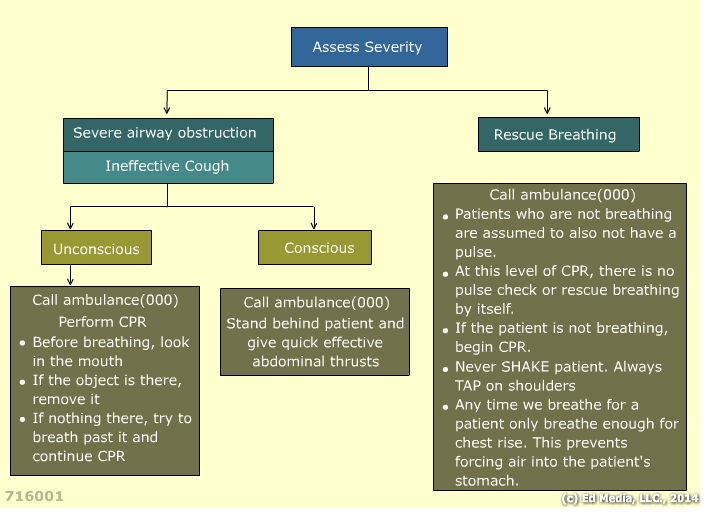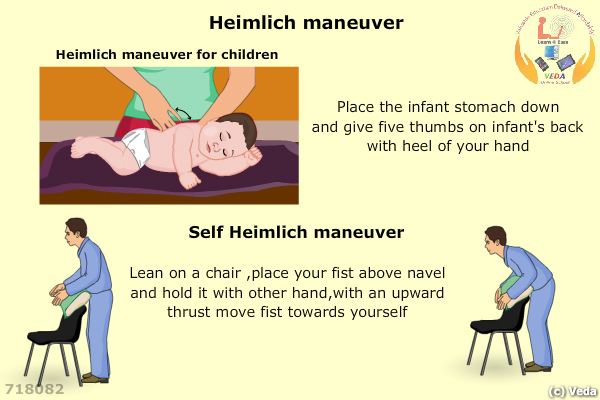Airway Obstruction
Airway obstruction, also known as choking, occurs when the airway i.e the route for passage of air into and out of the lungs, becomes blocked. In such situations, the restoration of breathing takes precedence over all other measures. The reason for this is simple that, if a casualty cannot breathe, he or she cannot live. Individuals who are choking may stop breathing and become unconscious. A common signal for choking is the casualty clutching at his or her throat with one or both hands. The most common causes of airway obstruction are swallowing large pieces of improperly chewed food, drinking alcohol before or during meals, and laughing while eating. The tongue is the most common cause of obstruction in a casualty who is unconscious. A foreign body can cause a partial or complete airway obstruction.

Partial Airway ObstructionIf the casualty can cough forcefully, and is able to speak, there is good air exchange. Encourage him or her to continue coughing in an attempt to dislodge the object. Do not interfere with the casualty’s efforts to remove the obstruction. First aid for a partial airway obstruction is limited to encouragement and observation. When good air exchange progresses to poor air exchange, demonstrated by a weak or ineffective cough, a high-pitched noise when inhaling, and a bluish discoloration (cyanosis) of the skin (around the finger nails and lips), treat the case as a complete airway obstruction.
Complete Airway ObstructionA complete airway obstruction presents with a completely blocked airway, and an inability to speak, cough, or breathe. If the casualty is conscious, he or she may display the common distress signal.
If the casualty is choking, do the following:
- Call for Help immediately – request medical assistance.
Administer abdominal thrusts (Heimlich Manoeuver):
- Stand behind the casualty.
- Place your arms around the casualties waist.
- Make a fist and place the thumb side against the middle of the abdomen, above the navel and below the tip (xiphoid process) of the (sternum) breastbone, in the soft abdominal tissue.
- Grasp your fist with your other hand.
- Keeping your elbows out, press your fist into the abdomen with a quick upward thrust.
- Repeat until the obstruction is clear or the casualty becomes unconscious.
If the casualty becomes unconscious, do the following:
- Finger sweep – Place the casualty on his or her back, open casualty’s mouth and grasp the tongue and lower jaw between your thumb and fingers, lift jaw with your index finger into the mouth along inside of cheek to base of tongue. Use “hooking” motion to dislodge object for removal. BUT, ONLY IF YOU SEE IT. NO BLIND FINGER SWEEPS.
- Open airway (Head-tilt/Chin-lift) -Place your hand on the casualty’s forehead. Place the fingers of your other hand under the bony part of the chin. Avoid putting pressure under the chin, it may cause an obstruction of the airway. Tilt the head and lift the jaw, avoid closing the casualty’s mouth. Place your ear over the casualty’s mouth and nose. Look at the chest, listen and feel for breathing for 3 to 5 seconds. If you suspect the casualty may have an injury to the head, neck, or back, you must minimize movement of the casualty when opening the airway. Kneeling at the top of the casualty’s head, place your elbows on the surface. Place your fingers behind the angle of the jaw or hook your fingers under the jaw, bring the jaw forward. Ensure that the head is not tilted and the neck is not extended.
- Give breaths – Pinch nose, open your mouth, take a deep breath, and make an air-tight seal around the casualty’s mouth. Give 2 breaths, each lasting 1 to 1 1/2 seconds and just enough to create chest rise. Pause between each breath. If unsuccessful, perform abdominal thrusts.
- If the airway is still obstructed perform CPR. Before each breath look into the mouth. If a foreign object is there, remove it and then attempt to breathe for the patient. If no foreign object is visible, just try to breathe for the patient.
- Continue the above steps-Until successful, you are exhausted, you are relieved by another trained individual, or by medical personnel.
If the casualty is found unconscious, do the following:
- Check for responsiveness – Tap but never shake. If there is a neck injury, this will not help the casualty.
- Shout for help·
- Check for breathing no more than 10 seconds
- Breathing? if no signs of head, neck or spinal cord injury log roll patient onto his side
- No breathing? begin CPR with chest compression
- 1st time you breathe, if the air does not go in, re-tilt and try again
- If the air still does not go in, open the mouth as described above and check for a foreign body obstruction. If you see something, pull it out. If not continue cpr checking the mouth before each breath.
CHOKINGChoking is usually caused by a large lump of food which sticks at the back of the throat and obstructs breathing. The person then becomes unconscious very quickly and will die in 4 to 6 minutes unless the obstruction is removed.
Choking can be mistaken for a heart attack. A person who is choking:
- May have been seen to be eating;
- Cannot speak or breathe;
- Will turn blue and lose consciousness quickly because of lack of oxygen;
- Can signal his distress (he cannot speak) by grasping his neck between fingers and thumb. This is known as the ‘Heimlich sign’ and, if understood by all personnel, should reduce the risks involved in choking.
If the casualty is conscious stand behind him, place your closed fist against the place in the upper abdomen where the ribs divide and grasp your fist with the other hand. Press suddenly and sharply into the casualty’s abdomen with a hard quick upward thrust. Repeat several times if necessary.
You may be able to treat yourself. Try to cough forcibly while using your fist as described. Alternatively, use the back of a chair, the corner of a table or sink, or any other projection which can be to produce a quick upward thrust to the upper abdomen.
If the casualty is unconscious, place him face upward and turn the face to one side, keeping the chin well up and the neck bent backwards. Kneel astride him, place one hand over the other with the heel of the lower hand at the place where the ribs divide. Press suddenly and sharply into the abdomen with a hard, quick upwards thrust. Repeat several times if necessary. When the food is dislodged remove it from the mouth and place the casualty in the unconscious position.


The following media explains about the First Aid for Choking :
Chest ThrustsThe chest thrust is the preferred method, in place of the abdominal thrust, for conscious individuals who are overweight or pregnant. Manual pressure to the abdominal area in these individuals can be ineffective if you cannot reach around the victim or cause serious damage. In case the casualty is overweight or pregnant, do the following:
1. Conscious – Standing or Sitting.
- Stand behind the casualty.
- Place your arms under the casualty’s armpits and around the chest.
- With your fist, place the thumb side against the middle of the breastbone.
- Grasp your fist with your other hand.
- Press your fist against the chest with a sharp, backward thrust until the obstruction is clear or casualty becomes unconscious.
2. Unconscious – Lying.
- Kneel down facing the casualty’s chest.
- Perform CPR, beginning with chest compression.
- Place the heel of one hand on the bare chest at the nipple line. Grasp this hand with the other hand.
- Keep your fingers off the casualty’s chest.
- Position your shoulders over your hands, with elbows locked and arms straight.
- Perform CPR with a look in the mouth to remove a foreign object before each breath.
- Each breath should be just enough to create chest rise.
- Repeat the last three steps until the obstruction is clear, or you are exhausted, or you are relieved by another trained individual or by a medical personnel.
Self Abdominal ThrustsIf you are alone and choking, try not to panic, you can perform an abdominal thrust on yourself by doing the following:
- If possible, phone for help.
- With the fist of your hand, place the thumb side against the middle of your abdomen, above the navel and below the tip of the breastbone. Grasp your fist with your other hand and give a quick upward thrust.
- You can also lean forward and press your abdomen over the back of a chair (with rounded edge), a railing, or a sink.


